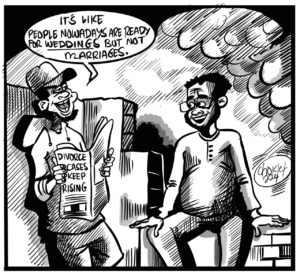The Lusaka Magistrate Court has admitted a video of Muvi TV’s ‘Assignment’ program into evidence in the matter where New Labour Party leader Fresher Siwale is charged with defamation of the President.
Principle resident magistrate Alice Walusiku ruled, Monday, that the video had met all the conditions required for the production of a video into evidence.
In this matter, Siwale is alleged to have on April 22, 2018, with intent to bring the name of President Edgar Lungu into ridicule, did publish defamatory matter by word of mouth to which he said ‘the President of the Republic of Zambia is not the actual Edgar Chagwa Lungu but Jonathan Mutawale, he must be arrested for having three National Registration Cards, he is an identity thief’.
In May this year, Muvi TV’s director of programs Mabvuto Phiri had testified that he he invited Siwale to feature on the Assignment program, where the latter branded President Lungu as an identity thief, with the aide of some scanned registration and voters cards.
And when the full Assignment program was viewed in court that day, defence lawyers Keith Mweemba and Gilbert Phiri had objected to the admittance of the video into evidence saying the rules of computer generated evidence had been breached.
They had argued that having viewed the contents of the program from the beginning to the end including things Phiri did not talk about, prejudiced the accused person and could amount to a mistrial.
The duo had further argued that Phiri had not told the court the model of the computer that he used and the scientific method he used to produce ID1 from the work station.
They had argued that the DVD was secondary evidence and secondary evidence could not be produced in the court of law when the original was in existence.
And when the matter came up for a ruling yesterday, magistrate Walusiku observed that the defence counsels, in their argument, had not provided the rule which stopped the court from viewing the contents of an exhibit before it was produced and therefore it was speculation.
She said the video evidence had been identified by the witness and he had mentioned it’s contents.
“Firstly the defence just said that there was no rule that allowed the court to view the contents of an exhibit before it was produced. The defence however did not provide that rule which did not allow the court not to view the contents of an exhibit before it was produced. Therefore it was a speculation,” she said.
“In this case, ID1 was identified by PW1 and PW1 mentioned the contents that the court was expected to find in the DVD, ID1. PW1 identified the said DVD and mentioned what the court was expected to find and he said that be was able to identify it. He said that it had a Muvi TV logo, the name of the program ‘Assignment’, his signature and a full stop before the word assignment. The contents were what accused person propagated [and] there were three video clips. This is what PW1 stated.”
Magistrate Walusiku observed that the witness was supposed to show the court what he was talking about and could only do that by viewing the said video.
She said the argument by the defence counsels that viewing the video evidence before production could amount to a mistrial, was aimed at misleading the court and defeating the course of justice.
“PW1 was supposed to show the court that what he purported to say, was what was in the said ID1. He was therefore supposed to show the court what he is talking about. It goes therefore that he could only show the court what he was talking about by way of viewing the said video to confirm that what he was saying was what was inside the said DVD. I wonder how PW1 was going to confirm that ID1 was what he purported it to be if the contents were not viewed? There is no other way that PW1 could have confirmed the contents without viewing it’s contents. Therefore the issue raised by the defence that viewing ID1 before production leads to a mistrial is aimed at misleading the court and defeating the course of justice,” she said.
And magistrate Walusiku ruled that there was no breach of computer generated evidence and that the video was the best evidence that the witness could have used.
“The second issue is the issue raised by the defence that the rules of evidence on computer generated evidence are being breached. PW1 told the court that the computer that was used was in good working condition and could not be tempered with. This excluded the danger of manipulation and as such there was no breach of computer generated evidence. In this case, ID1 was the best evidence that PW1 could have used,” she said.
Magistrate Walusiku further said that the court nowadays admitted all relevant evidence and did not just confine itself to the best evidence.
“On the issue that the computer at Muvi TV must be brought to court and not ID1, this is what I would like to say. Muvi TV is a national broadcaster and asking him to produce this gadget to court would make it impossible for them to work. ID1 therefore must be admitted. Nowadays we do not confine ourselves to the best evidence. We admit all relevant evidence. The goodness or badness of it goes only to the weight and not to the admissibility. ID1 one therefore is the best evidence and at the hands of PW1,” she said.
And on issue of the DVD not being brought in a sealed evidence bag, magistrate Walusiku said the defence counsels did not refer to the court as to which law of evidence said that.
She said there was nothing that placed a burden on a person producing an exhibit to place the evidence in a sealed bag.
Magistrate Walusiku ruled that foundation was led for the production of ID1 into video evidence.
“With the foregoing I’m satisfied that ID1 has met all the conditions required to production and as such I rule that ID1 has been admitted into evidence and is now marked P1,” ruled magistrate Walusiku.












